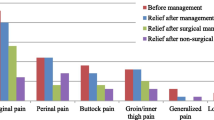Abstract
Introduction and hypothesis
Although the current literature discusses mesh complications including pain, as well as suggesting different techniques for removing mesh, there is little literature regarding pain outcomes after surgical removal or revision. The purpose of this study is to determine if surgical removal or revision of vaginal mesh improves patient’s subjective complaints of pelvic pain associated with original placement of mesh.
Methods
After obtaining approval from the Vanderbilt University Medical Center Institutional Review Board, a retrospective review of female patients with pain secondary to previous mesh placement who underwent excision or revision of vaginal mesh from January 2000 to August 2012 was performed. Patient age, relevant medical history including menopause status, previous hysterectomy, smoking status, and presence of diabetes, fibromyalgia, interstitial cystitis, and chronic pelvic pain, was obtained. Patients’ postoperative pain complaints were assessed.
Results
Of the 481 patients who underwent surgery for mesh revision, removal or urethrolysis, 233 patients met our inclusion criteria. One hundred and sixty-nine patients (73 %) reported that their pain improved, 19 (8 %) reported that their pain worsened, and 45 (19 %) reported that their pain remained unchanged after surgery. Prior history of chronic pelvic pain was associated with increased risk of failure of the procedure to relieve pain (OR 0.28, 95 % CI 0.12–0.64, p = 0.003).
Conclusions
Excision or revision of vaginal mesh appears to be effective in improving patients’ pain symptoms most of the time. Patients with a history of chronic pelvic pain are at an increased risk of no improvement or of worsening pain.
Similar content being viewed by others
References
Olsen AL, Smith VJ, Bergstrom JO et al (1997) Epidemiology of surgically managed pelvic organ prolapse and urinary incontinence. Obstet Gynecol 89:501
Rogo-Gupta L, Rodriguez LV, Litwin MS et al (2012) Trends in surgical mesh use of pelvic organ prolapse from 2000 to 2010. Obstet Gynecol 120:1105
US Food and Drug Administration (2011) FDA safety communication: update on serious complications associated with transvaginal placement of surgical mesh for pelvic organ prolapse. http://www.fda.gov/MedicalDevices/Safety/AlertsandNotices/ucm262435.htm Accessed 13 May 2013
Maher C, Feiner B, Baessier K et al (2007) Surgical management of pelvic organ prolapse in women. Cochrane Database Syst Rev 18:(3)CD004014
Diwadkar GB, Barber MD, Feiner B et al (2009) Complication and reoperation rates after apical vaginal prolapse surgical repair: a systematic review. Obstet Gynecol 113:367
Reynolds WS, Gold KP, Kauffman MR et al (2013) Immediate effects of the initial FDA notification on the use of surgical mesh for pelvic organ prolapse surgery in medicare beneficiaries. Neurourol Urodyn 32:330–335
Marcus-Braun N, Bourret A, von Theobald P (2012) Persistent pelvic pain following transvaginal mesh surgery: a cause for mesh removal. Eur J Obstet Gynecol 162:224
Chermansky CJ, Winters JC (2012) Complications of vaginal mesh surgery. Curr Opin Urol 22:287
Davila GW, Jijon A (2012) Managing vaginal mesh exposure/erosions. Curr Opin Obstet Gynecol 24:343
Gomelsky A, Dmochowski RR (2012) Vaginal mesh update. Curr Opin Urol 22:271
Zondervan KT et al (1999) Prevalence and incidence in primary care of chronic pelvic pain in women: evidence from a national general practice database. Br J Obstet Gynaecol 106:1149–1155
Harris PA, Taylor R, Thielke R et al (2009) Research electronic data capture (REDCap) - a metadata-driven methodology and workflow process for providing translational research informatics support. J Biomed Inform 42:377
Triolo O, Laganá AS, Sturlese E (2013) Chronic pelvic pain in endometriosis: an overview. J Clin Med Res 5:153
Butrick CW (2012) Interstitial cystitis/bladder pain syndrome management of the pain disorder: a urogynecology perspective. Urol Clin N Am 39:377
Klein F, Ospina C, Rudolph B et al (2012) Formation of a chronic pain syndrome due to mesh shrinkage after laparoscopic intraperitoneal only mesh (IPOM). Surg Laparosc Endosc Percutan Tech 22:288
Fisher HW, Lotze PM (2011) Nerve injury locations during retropubic sling procedures. Int Urogynecol J 22:439
Van Ba OL, Wagner L, de Tayrac R (2014) Obturator neuropathy: an adverse outcome of a trans-obturator vaginal mesh to repair pelvic organ prolapse. Int Urogynecol J 25:145–146
Horzic M, Vergles D, Cupurdija K et al (2011) Spontaneous mesh evacuation per rectum after incisional ventral hernia repair. Hernia 15:351
Conflicts of interest
None.
Author information
Authors and Affiliations
Corresponding author
Rights and permissions
About this article
Cite this article
Danford, J.M., Osborn, D.J., Reynolds, W.S. et al. Postoperative pain outcomes after transvaginal mesh revision. Int Urogynecol J 26, 65–69 (2015). https://doi.org/10.1007/s00192-014-2455-1
Received:
Accepted:
Published:
Issue Date:
DOI: https://doi.org/10.1007/s00192-014-2455-1




